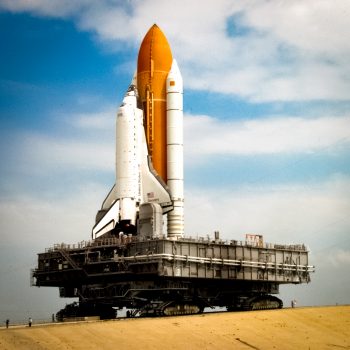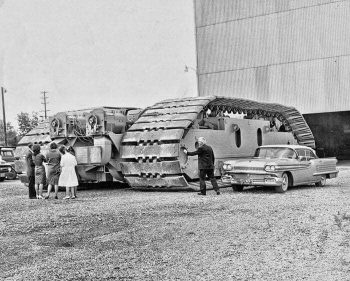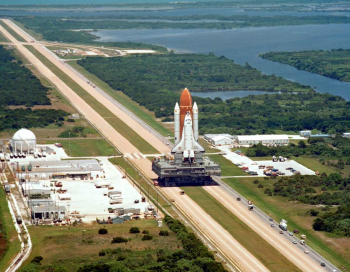
July 16, 2019, marks the 50th anniversary of the Apollo 11 launch. Marion, Ohio, in no small way, was part of that historic mission.
Between 1964-66, the former Marion Power Shovel Company designed and built two crawler-transporters – formally known as Missile Crawler Transporter Facilities – for NASA. These enormous tracked vehicles were originally used to ferry the Saturn rockets between Kennedy Space Center’s Vehicle Assembly Building and the launch pads. They also transported the Apollo rockets and, thus, began the voyage which resulted in Neil Armstrong, from nearby Wapakoneta, Ohio, becoming the first man to walk on the moon.
The idea for a crawler-launcher platform started when a NASA engineer visited his father’s farm near Paradise, Kentucky, and observed a giant strip mining shovel in operation. The shovel–that he described as having a platform as big as a football field, with tracks 8-feet high, and diesel engines in each track–was the Bucyrus-Erie Big Hog. If that engineer had driven a few more miles, he would have been equally in awe of the Marion Mountaineer in operation at another nearby mine.
 While the Bucyrus-Erie machine’s undercarriage sparked the design concept for the crawler-transporter, the Crawler Transporters which were eventually built were a Marion creation — the work of the talented Marion Power Shovel engineers. Their original goal was to build a system capable of moving extremely large structures, several miles, in a reasonable amount of time.
While the Bucyrus-Erie machine’s undercarriage sparked the design concept for the crawler-transporter, the Crawler Transporters which were eventually built were a Marion creation — the work of the talented Marion Power Shovel engineers. Their original goal was to build a system capable of moving extremely large structures, several miles, in a reasonable amount of time.
Each crawler-transporter is massive — weighing 6 million pounds and measuring 131 by 114 feet; the height from ground level to the platform can adjust from 20 to 26 feet. Each vehicle has eight tracks, two on each corner; each track has 57 shoes, and each shoe weighs 1,984 pounds. They are driven by 16 electric motors that are powered by four V16 diesel engines capable of moving the crawler forward at 1-2 miles per hour. The approximately four mile trip takes about six hours to traverse.
William C. Dwyer, then Vice President of Marion Power Shovel Company, was instrumental in Marion Power Shovel obtaining the NASA contract. He reminded NASA that his company had years of experience building large shovels, giant strip mining machines, and dragline machines going back to the Panama Canal and Hoover Dam projects. Marion won the NASA contract and the crawler-transporters were assembled in 1965-66 for under $15 million and ended up being worth billions over their 50-year service life.
While the original crawlers were retired from NASA use at the end of the space shuttle program in 2011, they have made their place in pop culture – represented most recently in the video game Fallout 3.The crawler-transporters have been featured in television and movies, including Dirty Jobs with Mike Rowe, the films Apollo 13 (1995), Transformers: Dark of the Moon (2011), Pacific Rim (2013), and this year’s Apollo 11. The largest self-powered land vehicles in the world, Marion Power Shovel’s crawler-transporters were added to the National Register of Historic Places on January 21, 2000.
 For decades, Marion residents and former Power Shovel employees have been proud of the accomplishment of the crawler-transporters and the talented engineers and workers that made them happen. Many of the large draglines Caterpillar now produces had their beginnings on Marion drawing boards and still carry the Marion Power Shovel model numbers.
For decades, Marion residents and former Power Shovel employees have been proud of the accomplishment of the crawler-transporters and the talented engineers and workers that made them happen. Many of the large draglines Caterpillar now produces had their beginnings on Marion drawing boards and still carry the Marion Power Shovel model numbers.
In addition to the crawler-transporters, Marion’s powered shovels and draglines constructed the Panama Canal, Hoover Dam, and many other public works projects across the country. At its peak, Marion Power Shovel employed 5,000-6,000 and was the world’s largest manufacturer of earth moving equipment. Their machines are still in use across the world.
#MarionMade #WeAreInnovative
Story contributors: Fred Hazen and Steven Gilmore. Thank you for sharing!


















